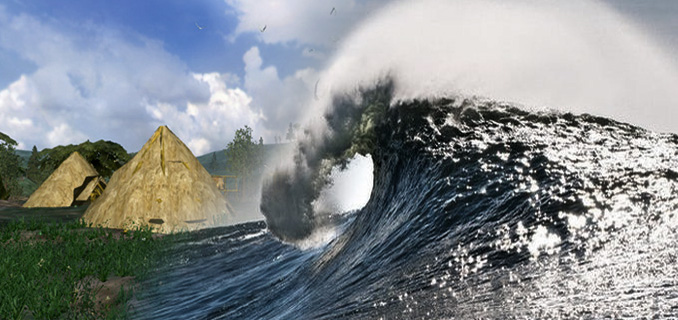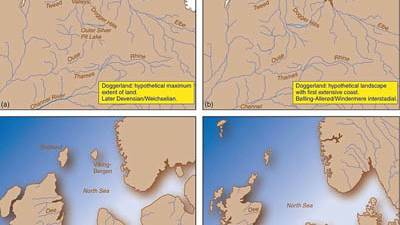The tsunami that obliterated Doggerland
Source: q-mag.org

Doggerland, now submerged under the North Sea, was the “True Heart of Europe” in the Mesolithic, according to Richard Bates, of the University of St-Andrews. It disappeared 8,000 years ago, destroyed by a tsunami triggered by the Störegga Landslide. A new computer simulation is trying to get a closer look at the event.
Our home in Doggerland...
 Some of our ancestors of the Stone Age had it good in Doggerland, the green land which once blossomed where the North Sea waves are now rolling. Hundreds of finds of stone implements, harpoons and human bones bear witness to the early settlement of what archaeologists refer to as the “Garden of Eden” of the Mesolithic, the true heart and cradle of Europe. During the last Ice Age, when sea-levels were lower, it would have been easy for man and animals to cross by foot from Northern Germany to Britain. And the incentive to roam and settle in Doggerland would have been strong indeed.
Some of our ancestors of the Stone Age had it good in Doggerland, the green land which once blossomed where the North Sea waves are now rolling. Hundreds of finds of stone implements, harpoons and human bones bear witness to the early settlement of what archaeologists refer to as the “Garden of Eden” of the Mesolithic, the true heart and cradle of Europe. During the last Ice Age, when sea-levels were lower, it would have been easy for man and animals to cross by foot from Northern Germany to Britain. And the incentive to roam and settle in Doggerland would have been strong indeed.The climate was mild. A large freshwater basin occupied the centre of Doggerland, fed by the River Thames from the west and by the Rhine in the east. The marshes and mudflats and lagoons would have offered shelter to thriving populations of birds, fish and mammals large and small. Wild fruit and berries were abundant. The vegetation was lush, with forests, meadows and marshes of reeds. Timber, firewood, grasses and fibers of all sorts were endlessly available.
But this Paradise was vulnerable. As the post-glacial thaw proceeded, the sea-levels kept rising. First to go in Doggerland were the marshes and the valleys. Then the settlements found themselves insularized. By 8,000 years ago, Doggerland had become a low-lying, marshy island covering an area about the size of Wales. And now scientists believe that they are able to show how Doggerland disappeared for good.


A new computer simulation of the Störegga Landslide
 The computer simulation by a team around Jon Hill of Imperial College London show dramatic events: tsunamis raced across the North Sea and swallowed the island. These are the first computer simulations which take into account the real water level at that time, Hill stated at the annual meeting of the European Geoscience Union (EGU) in Vienna.
The computer simulation by a team around Jon Hill of Imperial College London show dramatic events: tsunamis raced across the North Sea and swallowed the island. These are the first computer simulations which take into account the real water level at that time, Hill stated at the annual meeting of the European Geoscience Union (EGU) in Vienna.Their work confirms an old suspiscion: Doggerland fell victim to one of the greatest avalanches of all times. Around 8,000 years ago, along the coast of Norway, between Bergen and Trondheim, a staggering mass of glacial rubble the size of Iceland loosened itself and slipped down the continental slope into the depth of the North Sea, an event known as the Störegga Landslide. Just like a stone dropping in a puddle, the landslide created circular waves which propagated themselves with the speed of a fast train.
After a few hours, enormous waves hit coastlines. In many places, archaeologists have discovered traces left by this catastrophe: near Inverness, in the East of Scotland, the wave surprised people around a campfire; a 25 centimeter layer of sand and gravel covers their campsite, which at the time of the event was situated ten meters above sea level.
A mess of urchins, mussels and algies bears witness to the enormous wave which carried everything away.
In Norway, on the Shetland Isles and on the Faroe Islands, traces of the devastation can be found even higher up above the sea-level of the times. There, waves of up to 20 meters crashed into the land, according to Jon Hill. The dating of the layers yielded practically without exception an age of ca 8,000 years. Yet, until now, the consequences for Doggerland had been only speculated upon.
The Storegga Slide tsunami computer simulation on YouTube
A new computer simulation of the Störegga Landslide
The computer simulation by a team around Jon Hill of Imperial College London show dramatic events: tsunamis raced across the North Sea and swallowed the island. These are the first computer simulations which take into account the real water level at that time, Hill stated at the annual meeting of the European Geoscience Union (EGU) in Vienna.
Their work confirms an old suspiscion: Doggerland fell victim to one of the greatest avalanches of all times. Around 8,000 years ago, along the coast of Norway, between Bergen and Trondheim, a staggering mass of glacial rubble the size of Iceland loosened itself and slipped down the continental slope into the depth of the North Sea, an event known as the Störegga Landslide. Just like a stone dropping in a puddle, the landslide created circular waves which propagated themselves with the speed of a fast train.
After a few hours, enormous waves hit coastlines. In many places, archaeologists have discovered traces left by this catastrophe: near Inverness, in the East of Scotland, the wave surprised people around a campfire; a 25 centimeter layer of sand and gravel covers their campsite, which at the time of the event was situated ten meters above sea level.
A mess of urchins, mussels and algies bears witness to the enormous wave which carried everything away.
In Norway, on the Shetland Isles and on the Faroe Islands, traces of the devastation can be found even higher up above the sea-level of the times. There, waves of up to 20 meters crashed into the land, according to Jon Hill. The dating of the layers yielded practically without exception an age of ca 8,000 years. Yet, until now, the consequences for Doggerland had been only speculated upon.
The Flooding of Doggerland
In their work, Hill and his colleagues reconstructed the past landscape of Doggerland on their computers: “Large parts of Doggerland were then less than five meters above sea-level,” they say.
Their simulations show dramatic events: tsunami-waves of up to five meters ran over the island. “Doggerland could have been totally covered,” said Hill during his presentation at the EGU-meeting. Large tracts of the sandy soil were carried away. The Störegga landslide probably caused the end of all settlement on Doggerland, according to the scientists.
The fate of the island proved a lucky break for the coastlines behind them: Doggerland acted as a wave-breaker, so that the German North Sea coast, the Netherlands and Southern England were exposed to tsunamis of only one meter, according to Hill.
Still, there occurred violent flooding there, as well: tsunamis work their effects most of all through their extreme wavelength which can reach hundreds of kilometers inland, carrying rapid streams of water. The Frisian Islands too must have lost large masses of sand.
But Doggerland was dealt a devastating blow. At best some rudiments of the island probably stuck out of the North Sea after this, according to Hill. The old heart of Europe had ceased beating.
Axel Bojanowski
Translated by Anne-Marie de Grazia
Original article: Der Spiegel, 05.02.2014
Article from: q-mag.org
READ: ’Britain’s Atlantis’ found at bottom of North sea - a huge undersea world






















